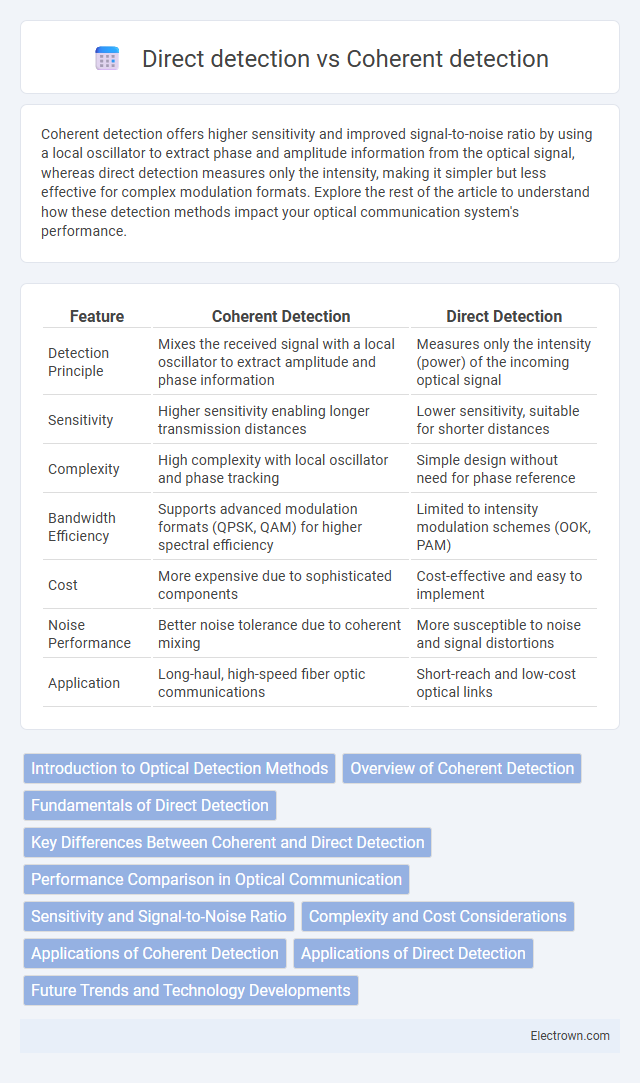Coherent detection offers higher sensitivity and improved signal-to-noise ratio by using a local oscillator to extract phase and amplitude information from the optical signal, whereas direct detection measures only the intensity, making it simpler but less effective for complex modulation formats. Explore the rest of the article to understand how these detection methods impact your optical communication system's performance.
Table of Comparison
| Feature | Coherent Detection | Direct Detection |
|---|---|---|
| Detection Principle | Mixes the received signal with a local oscillator to extract amplitude and phase information | Measures only the intensity (power) of the incoming optical signal |
| Sensitivity | Higher sensitivity enabling longer transmission distances | Lower sensitivity, suitable for shorter distances |
| Complexity | High complexity with local oscillator and phase tracking | Simple design without need for phase reference |
| Bandwidth Efficiency | Supports advanced modulation formats (QPSK, QAM) for higher spectral efficiency | Limited to intensity modulation schemes (OOK, PAM) |
| Cost | More expensive due to sophisticated components | Cost-effective and easy to implement |
| Noise Performance | Better noise tolerance due to coherent mixing | More susceptible to noise and signal distortions |
| Application | Long-haul, high-speed fiber optic communications | Short-reach and low-cost optical links |
Introduction to Optical Detection Methods
Optical detection methods in fiber optic communication primarily include coherent detection and direct detection, each relying on distinct signal processing principles. Direct detection measures only the intensity of incoming light, making it simpler and cost-effective but less sensitive to phase information. Coherent detection captures both amplitude and phase by mixing the signal with a local oscillator, enhancing sensitivity, spectral efficiency, and enabling advanced modulation formats.
Overview of Coherent Detection
Coherent detection employs a local oscillator laser to mix with the received signal, enabling extraction of both amplitude and phase information for superior sensitivity and higher data rates. This method is essential in advanced optical communication systems, such as coherent optical fiber networks, where signal integrity over long distances is critical. Your network's performance can significantly improve using coherent detection due to its ability to combat dispersion and noise more effectively than direct detection.
Fundamentals of Direct Detection
Direct detection involves measuring the intensity of an optical signal without requiring a local oscillator, relying solely on photodetectors to convert light into electrical signals. It fundamentally captures the power of the incoming light wave, providing a simpler and cost-effective method compared to coherent detection, which mixes the signal with a reference laser. The simplicity of direct detection offers advantages in terms of system design and lower complexity, especially for short-reach optical communication systems.
Key Differences Between Coherent and Direct Detection
Coherent detection utilizes a local oscillator to mix with the incoming optical signal, enabling extraction of both amplitude and phase information, which significantly enhances sensitivity and spectral efficiency in optical communication systems. Direct detection measures only the intensity of the optical signal without phase information, simplifying receiver design but limiting performance in high-capacity, long-distance transmissions. Your choice between these detection methods impacts system complexity, sensitivity, and data rate capabilities in applications such as fiber-optic networks and advanced modulation formats.
Performance Comparison in Optical Communication
Coherent detection in optical communication offers superior sensitivity and spectral efficiency compared to direct detection, enabling longer transmission distances and higher data rates. It utilizes phase and amplitude information of the optical signal, allowing advanced modulation formats such as QPSK and QAM, whereas direct detection only measures optical intensity. The enhanced performance of coherent detection significantly improves system resilience to noise and fiber impairments, making it the preferred choice for modern high-capacity optical networks.
Sensitivity and Signal-to-Noise Ratio
Coherent detection offers significantly higher sensitivity and improved Signal-to-Noise Ratio (SNR) compared to direct detection, making it ideal for weak signal environments. By mixing the incoming optical signal with a local oscillator, coherent detection enhances the ability to recover phase and amplitude information, boosting overall detection performance. Your communication system can achieve longer transmission distances and higher data rates due to the superior noise resilience and signal discrimination inherent in coherent detection technology.
Complexity and Cost Considerations
Coherent detection systems require advanced digital signal processing, local oscillators, and phase tracking components, making them significantly more complex and costly compared to direct detection systems. Direct detection relies on simpler photodetectors without phase information recovery, resulting in lower equipment costs and reduced operational complexity. Your choice depends on balancing system performance against budget and maintenance capabilities, with direct detection favored for cost-sensitive applications.
Applications of Coherent Detection
Coherent detection is widely applied in high-speed optical communication systems due to its superior sensitivity and ability to recover phase, amplitude, and polarization information from complex modulation formats like QPSK and QAM. It enables advanced digital signal processing techniques for dispersion compensation and polarization demultiplexing, essential in long-haul fiber optic networks and metro networks. Furthermore, coherent detection is crucial in emerging applications such as quantum key distribution and coherent lidar systems, where precise phase information is vital.
Applications of Direct Detection
Direct detection is widely used in short-reach optical communication systems such as data centers and passive optical networks (PONs) due to its lower cost and simpler receiver design compared to coherent detection. It efficiently supports applications like Metro Area Networks (MANs) and fiber-to-the-home (FTTH) deployments, where bandwidth demands are moderate and system complexity needs to be minimized. Your choice of direct detection technology can optimize network performance for scenarios requiring cost-effective, high-speed data transmission over relatively short distances.
Future Trends and Technology Developments
Future trends in coherent detection emphasize higher-order modulation formats and advanced digital signal processing to enhance spectral efficiency and reach in optical communication systems. Direct detection technology continues evolving with integrated photonics and simplified receiver architectures aimed at cost-effective short-reach applications and data center interconnects. Innovations such as machine learning algorithms and silicon photonics integration are driving the next generation of coherent and direct detection schemes, improving performance while reducing power consumption and complexity.
Coherent detection vs Direct detection Infographic

 electrown.com
electrown.com